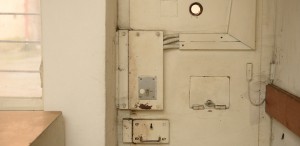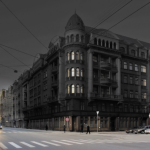The Corner House exhibition at the former Latvian SSR KGB building at Brivibas Street 61 in Riga reopened its doors to the public in February 2015.
As part of the Rīga 2014 European Capital of Culture programme, the former KGB building in Rīga opens to the public for the first time. The house was opened by the President of Latvia, Andris Bērziņš, and Director of the Rīga 2014 Foundation, Diāna Čivle.
The former building of the Committee for State Security of the Soviet Union in Rīga is known by numerous names – the Corner House, the KGB house – but regardless of what name is attributed to it every inhabitant of Latvia knows what this building is, and everyone has a story associated with it – family members or friends who were imprisoned, interrogated, or even shot inside the building, others who worked there, others still who were deported following orders signed in this building.
The KGB house has stood empty for many years – a sad testament to its horrific past. Opening up this edifice with exhibitions and cultural events will not only enable people to tackle their personal histories associated with this building, to see what is inside the notorious house, but will also create a space for discussion about the relationship between people and authority, between then and now, and, crucially, what can be done with this building in the future.
 The building was completed in 1912, designed by architect Aleksandrs Vanags in a neo-classical style, with notable art nouveau elements, as a residential apartment building. The grand entrances, mirrored entrance halls, high ceilings, numerous staircases are testament to the grandeur intended for its inhabitants. During the initial period of Latvian independence it was home to street level shops, offices, organisations. During the first occupation, at the start of the Second World War when Soviet forces occupied Latvia, the house was adapted to be an internal prison, and became the centre for State Security Service activities in occupied Latvia. With the exception of the Nazi occupation, the house served that same purpose up until 1991, when the Soviet Union collapsed. The Latvian police took over the building very briefly.
The building was completed in 1912, designed by architect Aleksandrs Vanags in a neo-classical style, with notable art nouveau elements, as a residential apartment building. The grand entrances, mirrored entrance halls, high ceilings, numerous staircases are testament to the grandeur intended for its inhabitants. During the initial period of Latvian independence it was home to street level shops, offices, organisations. During the first occupation, at the start of the Second World War when Soviet forces occupied Latvia, the house was adapted to be an internal prison, and became the centre for State Security Service activities in occupied Latvia. With the exception of the Nazi occupation, the house served that same purpose up until 1991, when the Soviet Union collapsed. The Latvian police took over the building very briefly.
And so it stands to this day as it was on the day the State Security Service of the Soviet Union fled from it in a hurry, with the chilling detention cells, interrogations rooms, the unsettling exercise yard, the street level shooting room and much more preserved as it was. The house is a museum in and of itself, and for the first time it will be able to serve that purpose to the public. Between 1 May and 19 October six exhibitions will be open to the public in the KGB house, which in different ways address the interaction between people and authority.
The corner house project is part of the Rīga 2014 European Capital of Culture programme, organised by the Rīga 2014 Foundation.
For more information please contact us by e-mail or call +371 6 7288 494.


